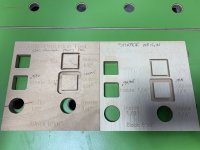What keeps me from buying a Shaper Origin is their
https://www.shapertools.com/de-de/terms#tc as of 26. September 2018 which with
2. Our License to you. Subject to these Terms of Service, we give you a limited, nonexclusive, nontransferable, revocable license to use the Sites, Services, and Products. [...] Shaper may limit your access to any Site, Service, or Product in its sole discretion.
states that you are unable to legally transfer ownership (as you're not able to transfer the license to use the build-in software) and access to something you paid for can be taken from you on a whim without even giving you a reason.
TL;DR: the moment your use case for Shaper Origin ends that thing has scrap value at best, sooner in case they unilaterally decide to turn it off.
Compare that to
(a) License to Shaper. You give Shaper (and those trusted third parties we work with) a non-exclusive, royalty-free, transferable, sublicensable, worldwide license to use, use, store, display, reproduce, save, modify, create derivative works, perform, and distribute your User Content solely for the purposes of operating, providing, improving, and developing the Shaper Sites, Services, and Products. When you post content to a public or shared space in the Sites, Services, or Products, such as our Community Forum, you also grant Shaper a royalty-free, perpetual, irrevocable, non-exclusive, unrestricted, worldwide license to reproduce, prepare derivative works, distribute copies, perform, or publicly display your User Content in any medium and for any purpose, including commercial purposes.
where you have no recourse or way to stop them from making money of your designs should they decide to. Please note that using the cloud feature of the shaper origin (eg. loading a shape into it via their website) technically is as case of
When you post content to a public or shared space in the Sites, Services, or Products, giving them the right to
rip-off legally use your IP
in any medium and for any purpose, including commercial.
TL;DR: what you upload to their cloud platform (even in your own partition) is no longer yours.
Then we have
17. Modification of these Terms of Service. These Terms of Service are subject to occasional change or update. Whenever the Terms of Service are materially changed, we will notify you, and the change will take effect 30 calendar days after notice is posted for existing users and immediately for new users. You are responsible for keeping your contact information up to date if you wish to receive notice of these changes. If you do not want to be subject to any changes in these Terms of Service, you must discontinue using our Services and Products before the change takes place. Continued use will serve as an acceptance of the changed Terms of Service
which basically codifies that they can change the ToS to turn your shaper origin into a pay-per-use device, grant them
ius primae noctis or whatever else evil things one can come up with... and the moment you turn on
your (*sig*) shaper origin the next time you agree to let them charge your VISA per mm routed, to bend over and relax or comply with whatever else they might come up with. And in case you're not agreeing you, as of the first quote, only have the option to scrap the machine as you're legally unable to sell it as fit for the original purpose since you can not transfer the software license...
TL;DR: you have no rights.
I have pointed that out to them, politely, 3 months ago, together with a list of other things incompatible with how things work here in Europe. While they have used the last three months to change some of the (for them) worst things that I found with their offering... the issue of their ToS is still as-is. Having given them enough time (akin to
responsible disclosure) to change this without effect... it's IMHO now reasonable to voice my dispraise for their terms of service and to advise others against spending money on a device that you will not own, a device that can be stopped to function without reason or notice, a device that when used in the advertised use scenario (while it's still functioning) will
steal transfer the rights to your designs to someone else without compensation.
________________________________________________________________________
The terms of service of ShaperTools are unacceptable and should not be accepted.
As of that Shaper Origin is, while things stay that way, not worth it.

